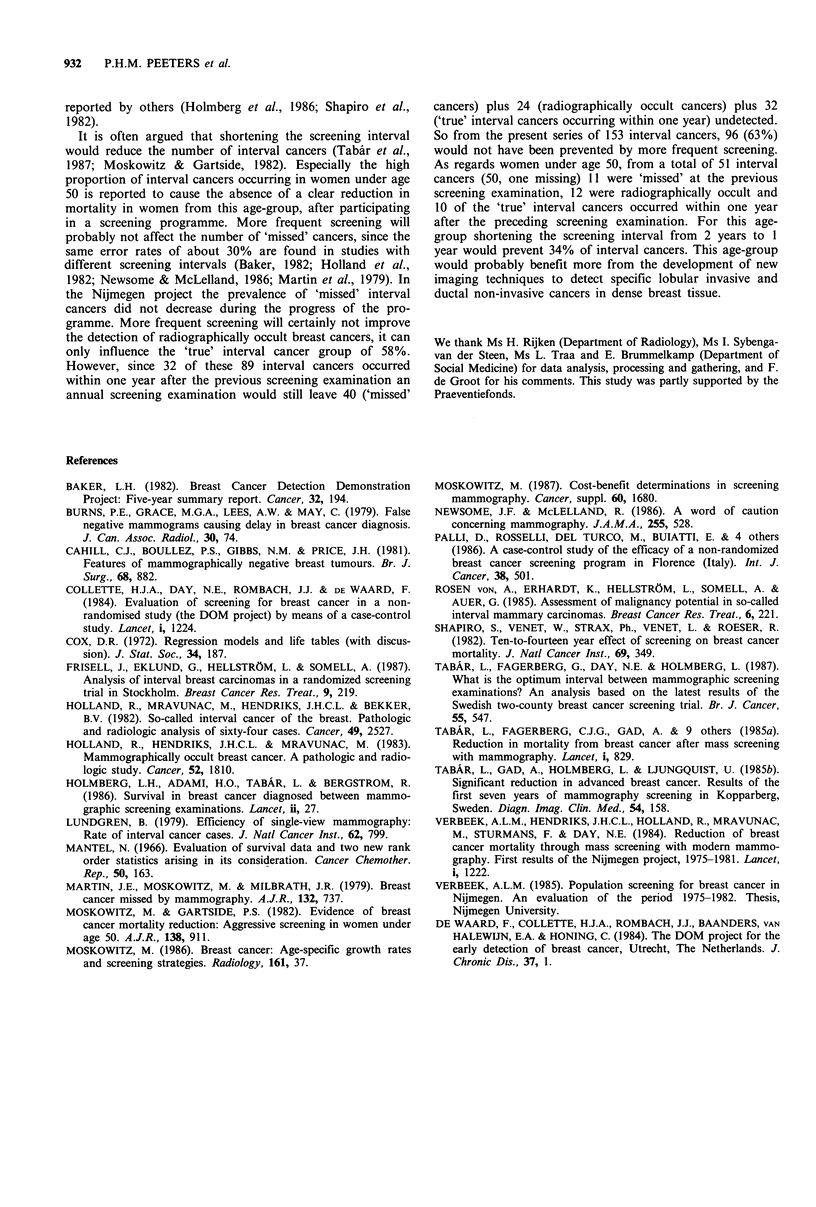Abstract
Since January 1975 a population-based screening programme for the early detection of breast cancer has been carried out in the city of Nijmegen. During five interscreening periods of 2 years each a total of 158 so-called interval cancers were diagnosed. Careful revision of all screening and diagnostic mammograms was executed. Of all interval cancers 26% were 'missed' at the previous screening examination (due to technical or observer error), 16% were radiographically occult at the time of diagnosis and 58% were 'true' interval cancers. Interval cancers were regarded as 'true' when an obvious lesion was observed on the diagnostic mammogram while no suspect signs were seen on the previous screening mammogram. The prevalence of 'missed' cancers did not decline in the course of the screening programme. Radiographically occult tumours were localised, mostly in Wolfe's P2/DY breast parenchyma (83%), 33% were lobular invasive and 25% ductal non-invasive. 'True' interval cancer cases (58%) showed the same overall survival as control breast cancer patients, diagnosed in a non-screening situation. Shortening the screening interval would reduce interval cancer rates and probably further decrease breast cancer mortality in a screened population. However, from the present series of interval cancers 63% would not have been prevented by an annual screening examination. As regards women under age 50 annual screening would still leave 66% of all interval cancers in this age group undetected. Probably more benefit will be gained by searching for new imaging techniques to reduce numbers of 'missed' cancers and to detect lobular invasive and ductal non-invasive cancers in dense breast parenchyma.
Full text
PDF



Selected References
These references are in PubMed. This may not be the complete list of references from this article.
- Baker L. H. Breast Cancer Detection Demonstration Project: five-year summary report. CA Cancer J Clin. 1982 Jul-Aug;32(4):194–225. doi: 10.3322/canjclin.32.4.194. [DOI] [PubMed] [Google Scholar]
- Burns P. E., Grace M. G., Lees A. W., May C. False negative mammograms causing delay in breast cancer diagnosis. J Can Assoc Radiol. 1979 Jun;30(2):74–76. [PubMed] [Google Scholar]
- Cahill C. J., Boulter P. S., Gibbs N. M., Price J. L. Features of mammorgraphically negative breast tumours. Br J Surg. 1981 Dec;68(12):882–884. doi: 10.1002/bjs.1800681215. [DOI] [PubMed] [Google Scholar]
- Collette H. J., Day N. E., Rombach J. J., de Waard F. Evaluation of screening for breast cancer in a non-randomised study (the DOM project) by means of a case-control study. Lancet. 1984 Jun 2;1(8388):1224–1226. doi: 10.1016/s0140-6736(84)91704-5. [DOI] [PubMed] [Google Scholar]
- Frisell J., Eklund G., Hellström L., Somell A. Analysis of interval breast carcinomas in a randomized screening trial in Stockholm. Breast Cancer Res Treat. 1987;9(3):219–225. doi: 10.1007/BF01806383. [DOI] [PubMed] [Google Scholar]
- Holland R., Hendriks J. H., Mravunac M. Mammographically occult breast cancer. A pathologic and radiologic study. Cancer. 1983 Nov 15;52(10):1810–1819. doi: 10.1002/1097-0142(19831115)52:10<1810::aid-cncr2820521009>3.0.co;2-f. [DOI] [PubMed] [Google Scholar]
- Holland R., Mravunac M., Hendriks J. H., Bekker B. V. So-called interval cancers of the breast. Pathologic and radiologic analysis of sixty-four cases. Cancer. 1982 Jun 15;49(12):2527–2533. doi: 10.1002/1097-0142(19820615)49:12<2527::aid-cncr2820491220>3.0.co;2-e. [DOI] [PubMed] [Google Scholar]
- Lundgren B. Efficiency of single-view mammography: rate of interval cancer cases. J Natl Cancer Inst. 1979 Apr;62(4):799–803. [PubMed] [Google Scholar]
- Mantel N. Evaluation of survival data and two new rank order statistics arising in its consideration. Cancer Chemother Rep. 1966 Mar;50(3):163–170. [PubMed] [Google Scholar]
- Martin J. E., Moskowitz M., Milbrath J. R. Breast cancer missed by mammography. AJR Am J Roentgenol. 1979 May;132(5):737–739. doi: 10.2214/ajr.132.5.737. [DOI] [PubMed] [Google Scholar]
- Moskowitz M. Breast cancer: age-specific growth rates and screening strategies. Radiology. 1986 Oct;161(1):37–41. doi: 10.1148/radiology.161.1.3532183. [DOI] [PubMed] [Google Scholar]
- Moskowitz M. Cost-benefit determinations in screening mammography. Cancer. 1987 Oct 1;60(7 Suppl):1680–1683. doi: 10.1002/1097-0142(19871001)60:1+<1680::aid-cncr2820601206>3.0.co;2-w. [DOI] [PubMed] [Google Scholar]
- Moskowitz M., Gartside P. S. Evidence of breast cancer mortality reduction: aggressive screening in women under age 50. AJR Am J Roentgenol. 1982 May;138(5):911–916. doi: 10.2214/ajr.138.5.911. [DOI] [PubMed] [Google Scholar]
- Newsome J. F., McLelland R. A word of caution concerning mammography. JAMA. 1986 Jan 24;255(4):528–528. [PubMed] [Google Scholar]
- Palli D., Del Turco M. R., Buiatti E., Carli S., Ciatto S., Toscani L., Maltoni G. A case-control study of the efficacy of a non-randomized breast cancer screening program in Florence (Italy). Int J Cancer. 1986 Oct 15;38(4):501–504. doi: 10.1002/ijc.2910380408. [DOI] [PubMed] [Google Scholar]
- Shapiro S., Venet W., Strax P., Venet L., Roeser R. Ten- to fourteen-year effect of screening on breast cancer mortality. J Natl Cancer Inst. 1982 Aug;69(2):349–355. [PubMed] [Google Scholar]
- Tabár L., Faberberg G., Day N. E., Holmberg L. What is the optimum interval between mammographic screening examinations? An analysis based on the latest results of the Swedish two-county breast cancer screening trial. Br J Cancer. 1987 May;55(5):547–551. doi: 10.1038/bjc.1987.112. [DOI] [PMC free article] [PubMed] [Google Scholar]
- Tabár L., Gad A., Holmberg L., Ljungquist U. Significant reduction in advanced breast cancer. Results of the first seven years of mammography screening in Kopparberg, Sweden. Diagn Imaging Clin Med. 1985;54(3-4):158–164. [PubMed] [Google Scholar]
- Verbeek A. L., Hendriks J. H., Holland R., Mravunac M., Sturmans F., Day N. E. Reduction of breast cancer mortality through mass screening with modern mammography. First results of the Nijmegen project, 1975-1981. Lancet. 1984 Jun 2;1(8388):1222–1224. doi: 10.1016/s0140-6736(84)91703-3. [DOI] [PubMed] [Google Scholar]
- de Waard F., Collette H. J., Rombach J. J., Baanders-van Halewijn E. A., Honing C. The DOM project for the early detection of breast cancer, Utrecht, The Netherlands. J Chronic Dis. 1984;37(1):1–44. doi: 10.1016/0021-9681(84)90123-1. [DOI] [PubMed] [Google Scholar]
- von Rosen A., Erhardt K., Hellström L., Somell A., Auer G. Assessment of malignancy potential in so-called interval mammary carcinomas. Breast Cancer Res Treat. 1985;6(3):221–227. doi: 10.1007/BF01806772. [DOI] [PubMed] [Google Scholar]


